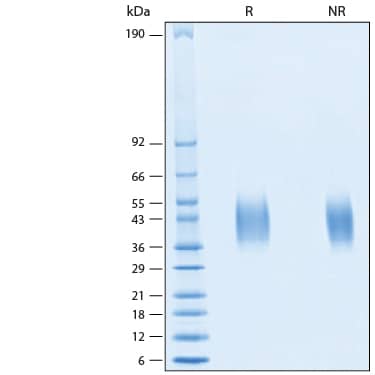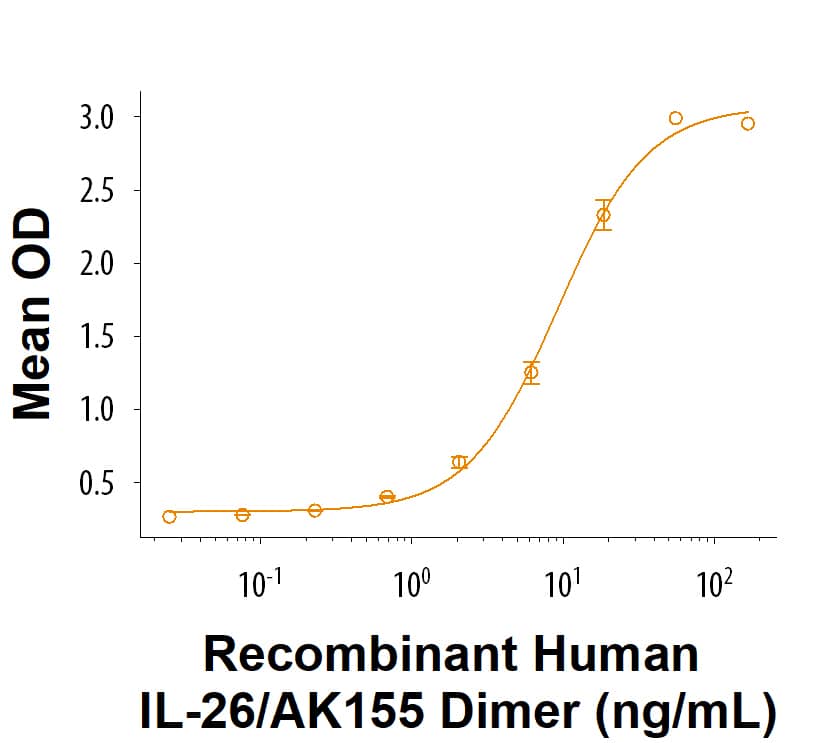Recombinant Human IL-20R alpha His-tag Protein, CF
R&D Systems, part of Bio-Techne | Catalog # 11239-IR

Key Product Details
Product Specifications
Source
Val30-Lys250, with a C-terminal 6-His tag
Purity
Endotoxin Level
N-terminal Sequence Analysis
Predicted Molecular Mass
SDS-PAGE
Activity
When Recombinant Human IL-20R alpha His-tag (Catalog # 11239-IR) is immobilized at 0.5 µg/mL (100 µL/well), Recombinant Human IL-26/AK155 Dimer (Catalog # 1870-IL) binds with an ED50 of 3.00-30.0 ng/mL.
Scientific Data Images for Recombinant Human IL-20R alpha His-tag Protein, CF
Recombinant Human IL-20R alpha His-tag Protein Binding Activity.
When Recombinant Human IL-20R alpha His-tag Protein (Catalog # 11239-IR) is immobilized at 0.5 µg/mL (100 µL/well), Recombinant Human IL‑26/AK155 Dimer Protein (1870-IL) binds with an ED50 of 3.00-30.0 ng/mL.Recombinant Human IL-20R alpha His-tag Protein SDS-PAGE.
2 μg/lane of Recombinant Human IL-20R alpha His-tag Protein (Catalog # 11239-IR) was resolved with SDS-PAGE under reducing (R) and non-reducing (NR) conditions and visualized by Coomassie® Blue staining, showing bands at 34-45 kDa.Formulation, Preparation and Storage
11239-IR
| Formulation | Lyophilized from a 0.2 μm filtered solution in PBS with Trehalose. |
| Reconstitution | Reconstitute at 500 μg/mL in PBS. |
| Shipping | The product is shipped at ambient temperature. Upon receipt, store it immediately at the temperature recommended below. |
| Stability & Storage | Use a manual defrost freezer and avoid repeated freeze-thaw cycles.
|
Background: IL-20R alpha
IL-20 receptor alpha (IL-20 R alpha), also named IL-20 R1, CRF2-8, and ZCYTOR7, belongs to the class II cytokine receptor family, which includes 12 members. These receptors are characterized by the patterns of conserved amino acid (aa) residues in their extracellular domains, which are composed of tandem fibronectin type III domains (1). Class II cytokine receptors form heterodimeric signaling receptor complexes that mediate class II cytokine signals. Subunits of the different receptor complexes are shared and serve multiple functions (1). The gene for human IL-20 R alpha is mapped to chromosome 6 and encodes a 553 aa glycoprotein with a 29 aa signal peptide, a 221 aa extracellular domain, a 24 aa transmembrane region and a 279 aa intracellular domain (2). IL-20 R alpha is widely expressed and is detected at high levels in multiple tissues including skin, testis, heart, placenta, salivary gland and prostate gland (1). The expression of IL-20 R alpha, together with that of IL-20 R beta, is upregulated in psoriatic skin lesions on keratinocytes, immune cells, and endothelial cells (1, 2). IL-20 R alpha heterodimerizes with IL-20 R beta to form the functional receptor that mediates IL-19, IL-20 and IL-24 signals (3, 4). IL-20 R alpha also heterodimerizes with IL-10 R beta to form the functional receptor complex for IL-26 (5). Binding of these IL-10 family class II cytokines to their functional receptors induces activation of the JAK-STAT signal transduction pathway. At low ligand concentrations, STAT3 has been shown to be the predominant STAT proteins activated through either complexes (3 - 5).
References
- Kotenko, S.V. (2003) Cytokine & Growth Factor Reviews 13:223.
- Xie, M.H. et al. (2000) J. Biol. Chem. 275:31335.
- Dumoutier, L. et al. (2001) J. Immunol. 167:3534.
- Parrish-Novak, J. et al. (2002) J. Biol. Chem. 277:47517s.
- Sheikh. F. et al. (2004) J. Immunol. 172:2006.
Long Name
Alternate Names
Gene Symbol
UniProt
Additional IL-20R alpha Products
Product Documents for Recombinant Human IL-20R alpha His-tag Protein, CF
Product Specific Notices for Recombinant Human IL-20R alpha His-tag Protein, CF
For research use only

